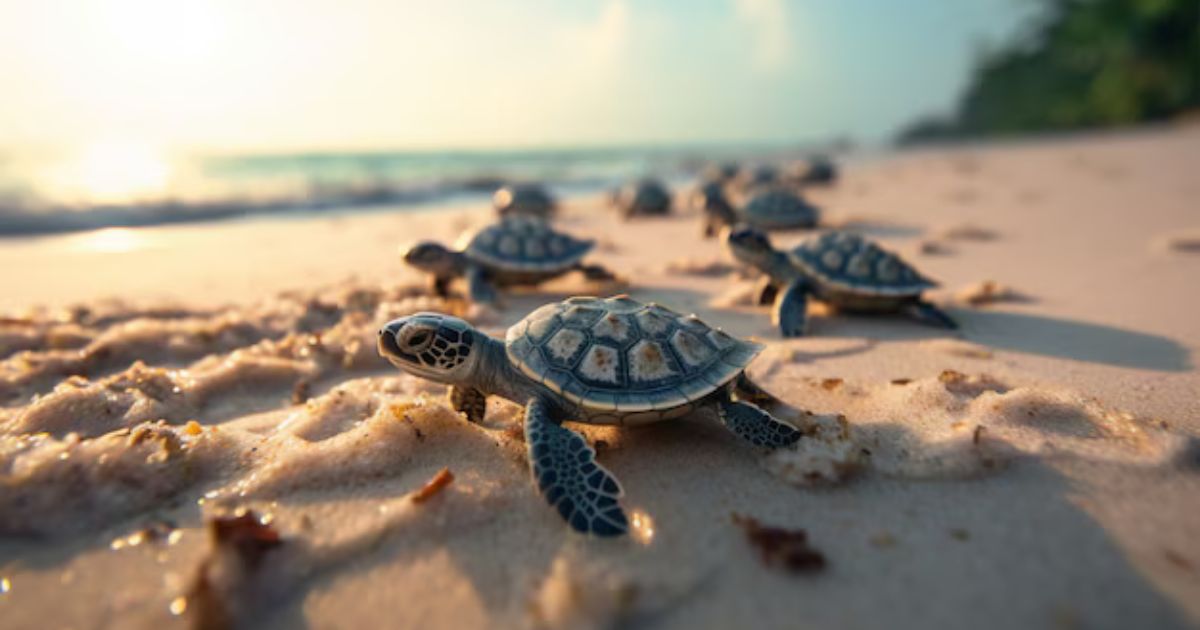Zanzibar, an exotic island off the coast of Tanzania, is home to stunning beaches, rich history, and incredible marine life. Among its most fascinating creatures are the sea turtles that inhabit its waters. These gentle giants play a crucial role in the marine ecosystem, but they face numerous threats from human activities. In this article, we’ll explore the sea turtles of Zanzibar, their habitats, conservation efforts, and the best ways to experience them responsibly.
Types of Sea Turtles in Zanzibar
Zanzibar’s warm waters are home to several species of sea turtles, but the most common ones found in the region include:
Green Sea Turtle (Chelonia mydas)
The green sea turtle is the most frequently spotted species in Zanzibar. Recognizable by its smooth, heart-shaped shell, this turtle is primarily herbivorous and thrives in seagrass meadows.
Hawksbill Sea Turtle (Eretmochelys imbricata)
This critically endangered species is known for its beautifully patterned shell, which has unfortunately made it a target for illegal hunting. Hawksbill turtles play a vital role in maintaining coral reef health by feeding on sponges.
Loggerhead Sea Turtle (Caretta caretta)
Though less common, the loggerhead sea turtle occasionally appears in Zanzibar’s waters. It has a large head and powerful jaws, perfect for crushing hard-shelled prey like crabs and mollusks.
Where to See Sea Turtles in Zanzibar
If you want to witness these majestic creatures in their natural habitat, there are several places in Zanzibar where you can do so.
Nungwi Mnarani Natural Aquarium
Located in the northern part of Zanzibar, the Nungwi Mnarani Natural Aquarium is a sanctuary for injured and rescued sea turtles. Visitors can learn about conservation efforts and even get the chance to feed and swim with rehabilitated turtles before they are released back into the ocean.
Prison Island (Changuu Island)
While Prison Island is famous for its giant tortoises, you may also spot sea turtles in the surrounding waters. Snorkeling around the island offers a chance to see sea turtles swimming in their natural environment.
Mnemba Atoll
This marine conservation area, located near Zanzibar’s main island, is one of the best snorkeling and diving spots. Sea turtles are often seen gliding gracefully through the crystal-clear waters alongside vibrant fish and coral reefs.
The Life Cycle of Zanzibar’s Sea Turtles
Understanding the life cycle of sea turtles highlights the importance of conservation efforts.
Nesting
Female sea turtles return to Zanzibar’s beaches to lay their eggs, usually between February and July. A single female can lay up to 100 eggs in a single nest.
Hatching
After about two months, the baby turtles hatch and make their way to the ocean. Only a small percentage survive, as many fall prey to predators like birds and crabs.
Maturation
Turtles that survive reach maturity after 20–50 years. They spend their lives migrating across the ocean but often return to their birthplace to lay eggs.
Threats to Sea Turtles in Zanzibar
Despite their resilience, sea turtles face numerous challenges, many of which are caused by human activities.
Poaching and Illegal Trade
Sea turtles and their eggs are often hunted for their meat, shells, and oil. The hawksbill turtle, in particular, has been heavily targeted for its shell, used in jewelry and souvenirs.
Habitat Destruction
Coastal development, pollution, and beach erosion threaten the nesting sites of sea turtles. Artificial lights near beaches can also confuse hatchlings, leading them away from the ocean.
Fishing Bycatch
Accidental capture in fishing nets is one of the biggest threats to sea turtles. Many turtles drown when caught in large trawl nets, longlines, or discarded fishing gear.
Conservation Efforts in Zanzibar
To protect these amazing creatures, various conservation projects and local organizations have stepped up.
Marine Protected Areas
Places like Mnemba Atoll and Chumbe Island are designated marine protected areas where fishing and other harmful activities are restricted. These areas serve as safe havens for sea turtles.
Turtle Rehabilitation Centers
Facilities like the Nungwi Mnarani Natural Aquarium rescue injured turtles, care for them, and release them back into the wild. These centers also educate locals and tourists about the importance of turtle conservation.
Eco-Tourism and Community Involvement
Local communities are being encouraged to participate in conservation through eco-tourism. Instead of hunting turtles, they now earn a living by guiding turtle tours and protecting nesting sites.
How Tourists Can Help Protect Sea Turtles
If you’re visiting Zanzibar, here’s how you can contribute to turtle conservation:
Choose Responsible Tour Operators – Support eco-friendly businesses that prioritize wildlife protection.
Avoid Buying Turtle Products – Never purchase souvenirs made from turtle shells or other animal parts.
Reduce Plastic Use – Sea turtles often mistake plastic waste for food, leading to fatal health issues.
Respect Nesting Sites – If you visit a beach during nesting season, avoid disturbing the nests or using bright lights at night.
Conclusion
Zanzibar’s sea turtles, crucial to the island’s marine ecosystem, require conservation efforts and responsible tourism to thrive. Experience swimming with them in Mnemba Atoll or learning about them at rehabilitation centers.
FAQs
When is the best time to see sea turtles in Zanzibar?
The best time to see sea turtles is between February and July when they come ashore to nest. However, they can be spotted year-round while snorkeling or diving.
Can I swim with sea turtles in Zanzibar?
Yes! Mnemba Atoll and Nungwi Natural Aquarium offer opportunities to swim with sea turtles in a safe and responsible manner.
Are sea turtles dangerous?
No, sea turtles are gentle and non-aggressive creatures. However, they should be observed from a distance to avoid stress or harm.
How long do sea turtles live?
Sea turtles can live between 50 and 100 years, depending on the species and environmental factors.
How can I support sea turtle conservation in Zanzibar?
You can support conservation by visiting ethical turtle sanctuaries, reducing plastic waste, and spreading awareness about the threats facing sea turtles.











